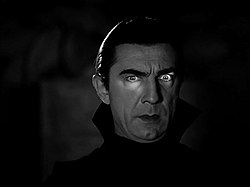Count Dracula
| Count Dracula | |
|---|---|
| Dracula character | |
 Count Dracula as portrayed by Bela Lugosi in 1931's Dracula |
|
| Created by | Bram Stoker |
| Portrayed by | See below |
| Information | |
| Nickname(s) |
Evil Eye Ordog Pokol Stregoika Vrolok Vlkoslag D. Nosferatu |
| Aliases | Dracula Count De Ville Mr. De Ville |
| Species |
Vampire Undead human Werewolf |
| Gender | Male |
| Title | Transylvanian Noble Voivode of Wallachia Solomonari Vampire King |
| Spouse(s) | Brides of Dracula |
| Nationality | Székely |
Count Dracula is the title character and main antagonist of Bram Stoker's 1897 gothic horror novel Dracula. He is considered to be both the prototypical and the archetypal vampire in subsequent works of fiction. He is also depicted in the novel to be the origin of werewolf legends. Some aspects of the character are believed to have been inspired by the 15th-century Wallachian Prince Vlad III the Impaler, who was also known as Dracula. Other character aspects have been added or altered in subsequent popular fictional works. The character has subsequently appeared frequently in popular culture, from films to animated media to breakfast cereals.
Bram Stoker's novel takes the form of an epistolary tale, in which Count Dracula's characteristics, powers, abilities and weaknesses are narrated by multiple narrators, from different perspectives.
Count Dracula is an undead, centuries-old vampire, and a Transylvanian nobleman who claims to be a Székely descended from Attila the Hun. He inhabits a decaying castle in the Carpathian Mountains near the Borgo Pass. Unlike the vampires of Eastern European folklore, which are portrayed as repulsive, corpse-like creatures, Dracula exudes a veneer of aristocratic charm. In his conversations with Jonathan Harker, he reveals himself as deeply proud of his boyar heritage and nostalgic for the past, which he admits have become only a memory of heroism, honour and valour in modern times.
...
Wikipedia
